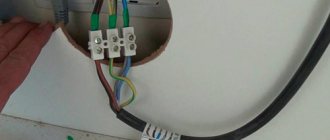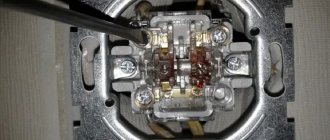All about electric generators and power plants
When a gasoline generator produces low voltage at idle or under rated load, it is necessary to identify and eliminate defects in the gasoline generator as quickly as possible in order to minimize the damage from malfunctions at an early stage of the breakdown.
One of the most common reasons why the generator does not produce voltage or produces low voltage during normal engine operation is simple oxidation or burning of the contacts of the power wires, machine or socket at the output of the gas generator. Such defects occur when equipment is stored for a long time in unfavorable conditions or when the generator operates under harsh conditions at loads close to maximum.
What needs to be done: use a multimeter or tester to check the voltage at the output terminals of the generator - from the terminal box of the generator itself (the thickest wires) to the outlet. To check the entire output circuit, you may have to open the protective cover or even open the generator control panel with a screwdriver. If no traces of corrosion or burnt contacts are visually visible, use a device along the entire circuit to look for the place where the voltage sags. The most painful places are the contacts on the socket, the fuse box, as well as the burning of the circuit breaker on the control panel. Defective areas must be cleaned and re-soldered efficiently. Replace burnt wires or the circuit breaker with new ones or known good ones.
Low voltage, and power circuits are working.
If the output power circuits are working properly, and the gasoline generator still produces low voltage, you should proceed to the next step - diagnosing the AVR generator voltage regulator. Diagnostics should again begin with a visual inspection of the voltage regulator unit. If burn marks are clearly visible on the AVR unit or if the capacitor is clearly swollen, then with a high degree of probability the reason for the absence or low voltage of the generator is hidden here.
What needs to be done: replace the voltage regulator unit with a new or working one. If you do not have the opportunity to purchase or borrow at least temporarily a known-good voltage regulator, you can read how to repair the AVR yourself using improvised means.
Troubleshooting procedure
Checking the gas generator for serviceability and diagnosing the electrical part is carried out with the external line disconnected. That is, the wires connected to the output terminals are discarded.
Voltage rating measurement
It doesn’t “give off tension” – the concept is quite vague. It is necessary to check whether there is at least some voltage at the output terminals, or whether it is completely absent. What will it give? First of all, the presence of a denomination, even a greatly underestimated one, indicates that there are no obvious breaks in the scheme. Such preliminary diagnosis greatly facilitates solving the problem.
Visual inspection of the gas generator
Any repair of a technical device, regardless of the nature of the breakdown, begins with this. It is necessary to review all visible parts and elements of the gas generator circuit. Since the unit vibrates during operation, most malfunctions are associated with loose contacts. The solution is simple - not just check the reliability of all electrical connections, but also “tighten” them, at least for prevention.
Units of this group are available in various modifications. For example, inverter models contain electronic units. It is necessary to remove the protective caps (covers) and carefully inspect the boards. Signs of a malfunction are melted (burnt) radio components (for example, mica capacitors, resistors), burnouts on the PCB, and torn tracks. Upon careful inspection, such defects are easy to identify and, indeed, to eliminate.
If the generator ATS is working and the voltage is still low.
If, even after replacing the voltage regulator, the gas generator still produces low voltage, then you most likely have the most unpleasant type of breakdown - an interturn short circuit of the generator windings. You can finally verify this by ringing the windings with a multimeter or tester.
What needs to be done: you need to rewind the generator stator. If your engine's service life has not yet been exhausted, it may be economically feasible to buy a new generator. In Chinese online stores you can very inexpensively purchase an alternator of the required power for mere pennies.
I would like to dwell separately on the issue of purchasing serviceable spare parts for your generator. Since the most problematic and expensive part of a gas generator is still the internal combustion engine, there are quite a lot of offers online to sell gasoline generators that have problems with the engine or fuel system inexpensively or even very cheaply. Do not ignore such advertisements if someone is selling a faulty gas generator of the same model as yours. If your gas generator does not produce the nominal 220V or 380V at the most inopportune moment, then such a donor - a gas generator, from which you can rearrange the necessary part in a few minutes, can help you out a lot, reducing the time and cost of repairs to a minimum!
We hope that our article helped you, and you can now figure out on your own what to do with a gas generator if the generator produces low voltage at idle or at rated engine speed.
We remind you that using the necessary spare parts for a gasoline generator and a kit for running on gas, you can independently convert the gasoline generator into a gas generator with the ability to run on gasoline.
Many people have a need to provide their home with an uninterrupted power supply system - the quality of domestic electricity supply is low, which is especially typical for suburban and rural areas. The most common solution is to purchase a gas generator - these devices are available in a wide range and have an affordable price. However, a gas generator, being a rather complex device, has many features, the knowledge of which is necessary for every owner to properly use such equipment.
What causes malfunctions?
Conventionally, a gas generator consists of two blocks: an engine and an alternator. All other equipment that may be present on a gas generator are systems that complement the first and second parts, or units that expand functionality. Most often, gasoline generators are repaired for the following reasons:
- Poor quality parts or workmanship
- Violation of operating rules
- Late service
- Result of normal wear and tear
Each gas generator is equipped with an instruction manual, which describes in detail the technical features of the product, requirements for the conditions in which the device will be used, operating rules, and a table-calendar of maintenance work. Strict adherence to the instructions in the operating manual allows you to minimize the risk of malfunctions over a long period of time.
Lack of oil, fuel, air supply
If the engine does not start or stalls, this means that the protective system has responded to the following factors:
- Lack of fuel - Even if gasoline is present, the fuel filter may be dirty.
- Lack of air - the air filter needs to be cleaned.
- Lack of oil - check its level.
Also, evidence of a breakdown may include smoke, exhaust of an uncharacteristic color, a sharp decrease in power, overheating, uneven operation of the gasoline generator, and increased oil consumption. These symptoms may be the result of wear of the piston rings, piston, cylinder, or violation of the internal geometry of certain elements. With such symptoms, high-quality diagnostics and repair of the gas generator engine is necessary.
The engine does not gain the power declared by the manufacturer
Causes and solutions:
- Insufficiently tightened spark plugs (need to tighten or replace the spark plug gasket);
- Loose cylinder head (tighten the mounting bolts more or replace the gasket);
- Piston rings are stuck or worn (rings need to be replaced)
- Worn piston or cylinder (needs repair or replacement)
- Poor contact between valve and seat faces (needs repair or replacement)
- The piston rod is stuck (needs repair or replacement)
- The gap between the valves differs from the gap specified for this model (adjustment of the gap is necessary)
Problems in the ignition system
- Spark plug faulty (plug replacement required)
- Malfunction of the ignition coil (replacement of the coil is necessary)
- The size of the air gap between the ignition coil and the flywheel differs from the size of the gap provided for this model (adjustment of the gap size is necessary)
- Demagnetized magneto (magneto needs to be replaced)
Poor fuel system performance
- The carburetor is clogged (disassembly and cleaning of the carburetor is necessary)
- The filter or hose is clogged (the hose needs to be cleaned or replaced)
- Air gets into the fuel hose (checking and adjusting connections)
- Low quality gasoline or gasoline diluted with water (replace gasoline with no higher quality)
Weakness of air flow
- The air filter is clogged (needs cleaning or replacement)
- Broken fuel valve (needs repair or replacement)
Problems with the ignition system
The spark plug fails for several reasons: an increase in the distance between the electrodes due to natural wear, mechanical damage to the spark plug. In such cases, the spark plug will have to be replaced. Coking of the electrodes is a consequence of working with low-quality or old fuel, as well as suboptimal engine loads. The coked spark plug must be unscrewed and the electrodes thoroughly cleaned. Another reason for the engine not starting may be a loose spark plug cap.
Malfunctions associated with the operation of the electric generator
Most often, a gasoline generator in the budget and mid-price segment is equipped with a brush synchronous alternator, which copes well with the imposed loads and is relatively cheap. However, it has some disadvantages:
- The need to periodically replace brushes
- Sensitivity to dust and high humidity
Untimely replacement of brushes can damage the entire alternator, which will entail additional costs. Alternator failure can also result from operating the device in polluted conditions.
The cause of a malfunction of a gasoline generator may be wires that are subjected to mechanical and temperature influences during operation - loss of contact, short circuit, chafing, rupture. Diagnostics and repair of electrical wiring must be carried out by qualified specialists.
The gas generator works intermittently
A malfunction of the regulator is signaled by a situation when the revolutions of the gas generator fluctuate under load, and there are interruptions in starting a cold and hot engine. If measures are not taken, the situation will be aggravated by premature wear of internal components and failure of the device.
Adjusting the frequency of a gasoline generator can solve the problem, but it must be done correctly. The work will require a tester for measuring frequency and a long screwdriver with a Phillips head. Compliance with the given algorithm of actions will allow you to perform power plant maintenance quickly and safely:
- The first step is to disassemble the carburetor to gain access to the fuel jets. Then, using a compressor, carefully blow out the jets, channels and emulsion tube.
- The next task is to find the quantity screw and set the throttle valve so that the minimum gap value is 1.5 mm. Upon completion of the manipulation, the output parameters are checked. The value should not go beyond the range of 210-235 V. It is optimal to achieve a balance between the number of generated revolutions and voltage.
- Next, you need to work with the mixture quality screw to eliminate interruptions during idle. It is found in a special hole, screwed until it stops, and then loosened two or three turns. During the adjustment process, make sure that the device operates without problems during a cold engine start or at idle.
Gasoline generator does not produce voltage
In case of problems with the electrical system: the gas generator does not produce 220v voltage, the user will learn how to correct this situation from the current section. Most often the problem occurs due to wear on the brushes. If self-diagnosis confirms this theory, in order to restore the functionality of the power plant, the brushes are removed, the degree of wear is assessed and replaced with new consumables.
The work will require a screwdriver, since the user will need to set the pressure spring on the brushes. After completion of the service, the device is assembled and a test run is carried out. The frequency of brush replacement is determined by the intensity of use of the device to generate current.
The gas generator produces low voltage
Due to oxidation or burning of the machine contacts, power drives or outlet sockets, the gas generator in use does not hold the load or produces low voltage. Situations often arise when the device is turned on in harsh conditions and the engine is running at maximum loads.
The user can correct defects as follows:
- The voltage at the terminals is checked using a multimeter.
- If the inspection does not reveal the presence of burnt contacts and traces of corrosion, you need to check the entire circuit and find areas where, according to the tester, the voltage sags.
- Identified areas with defects are cleaned and soldered. Burnt wires and faulty circuit breakers are replaced.
The gas generator stalls after starting
Does the device’s engine stall immediately after starting, and its startup is accompanied by uncharacteristic sounds? The cause of the breakdown most likely lies in a malfunction or contamination of the spark plugs. Replacing them or cleaning them from carbon deposits are the simplest operations that every home craftsman can perform on his own.
There is no need to contact a service center even if the power plant motor stalls due to incorrectly adjusted clearances. Armed with a screwdriver, the master will have to bend the candle petal to the optimal distance, and then make sure that a spark will jump between the elements.
Emergency generator start
Sometimes it happens that the generator urgently needs to be started, but the manual starter fails at that very moment. If necessary, there are several methods for emergency starting.
The methods listed below are not safe !
Remove the starter housing. Below it is a flywheel with a cooling impeller, pulled to the crankshaft by a nut. To set it in rotation, you can:
- Wrap a rope around the flywheel and use it in the same way as a recoil starter cable. Please note that if it gets caught on the fan blades, when the engine starts, this rope will turn into a whip whipping in all directions, so be careful. Stand so that the rope cannot hit your hands or head.
- Low-power engines can also be started manually: with the ignition off, turn the crankshaft several times, rotating the pulley by hand in the desired direction. In this case, the gas tap must be open and the starter flap must be closed. After this, turning on the ignition, bring the crankshaft to compression TDC (you will feel an increase in force on the flywheel), and then turn the pulley with a sharp jerk so that the spark energy is enough to ignite the mixture.
- A powerful cordless drill and a head with an extension from the tool kit are a good quick replacement for an electric starter. Clamp the extension in the chuck, put a socket of a suitable size on it and unscrew the crankshaft by the flywheel mounting nut. True, in this way it will only be possible to start a low-power generator - for a large-volume engine, the torque of the drill is not enough to turn it on the compression stroke.
What kind of work can you do yourself?
Almost all typical gas generator malfunctions and methods for eliminating them are prescribed in the instructions for use. Manipulations that the user can carry out independently:
- Cleaning filters
- Filling oil
- Fuel replacement
- Replacing and cleaning the spark plug
All other actions involve penetration into the internal structure of the gas generator. Such work can only be performed by certified specialists. Even if you have certain skills, you should know that repairing a gas generator with your own hands entails loss of warranty from the manufacturer and, as a result, unnecessary costs.
Where do quality equipment repairs take place?
Due to its operation, the gas generator periodically requires maintenance and, if necessary, repairs. Our company carries out diagnostics and repair of gas generators, as well as their scheduled maintenance. Personnel regularly undergo all necessary certifications at official representative offices of manufacturing plants. Repairs and diagnostics are carried out using modern equipment in a short time. By contacting us, you entrust your equipment to the best specialists.
Over time, even the most reliable and high-quality equipment can malfunction (cause the gas generator does not start). The gas generator is no exception. There can be many reasons for this. Most owners begin to panic and turn to specialists for help, but in fact, some problems can be fixed on their own, so to speak, at home. In this article, we will tell you what reasons there may be why a gasoline power plant does not start, and how you can deal with it.
There may be several reasons why it won't start. So, let's look at the possible reasons why the gas generator does not start at all or why when it starts, it immediately “stalls out”. The three main components on which the operation of a carburetor engine rests are gasoline, air and spark. You probably already guessed that we need to check these three devices that are necessary for the engine to operate properly.
1. Lack of gasoline in the tank
The owner of a gas generator may incorrectly calculate the required amount of fuel or simply forget to fill the fuel tank. First, you need to check the path (through which fuel is supplied to the carburetor). Secondly, the gasoline mixture may be outdated, that is, it has lost its octane properties. What can be done? Pour fresh mixture into the fuel tank and try to start the generator again.
It is important to remember that there is a tap on the tube under the gas tank. So, you need to carefully ensure that it is open.
3. Fuel hose
Need to check if it is leaking? If it leaks or becomes unusable, replace it.
The generator may not start because there is no spark.
What to do? First you need to unscrew the spark plug, check its condition, the presence of a spark, and if necessary, replace it with a new one. If the spark plug is filled with fuel mixture, it must be unscrewed and dried. Carbon deposits on the spark plug - clean it with an awl or needle; the electrodes can be cleaned with sandpaper. If there is heavy carbon deposits, replace with a new one. A dry spark plug means that there is a problem with the fuel supply to the cylinder. If there is a spark and the generator does not start, most likely there is no fuel in the carburetor. Another reason why there is no spark is a possible sticking of the oil sensor.
If there is no spark, pay attention to the oil level sensor
Read more about the oil sensor and the oil itself.....
In generators, especially inexpensive ones, the oil level sensor may malfunction, and this is often the reason the engine stops. In such a situation, it is necessary to check whether the sensor is working, whether there is oil in the crankcase and, if necessary, replace it. — It’s important to remember! It is a very big risk to disconnect the oil level sensor, since this is engine protection. — If the automatic oil level control system is triggered, then you need to check the oil level and, if necessary, top up.
5. Air filter
The next possible reason why the generator does not start may be a dirty air filter. An unclean filter prevents the passage of the amount of air necessary for fuel combustion. What can be done? Remove it, wash it or clean it thoroughly, dry it, then put it back in place. Important to remember! When starting the device, the air damper must be in the “closed” position.
If the engine fails to start, then we check the fuel system.
What can a teapot do?
- If fuel flows and there is a spark, then tighten the worn spark plug again and start it according to the instructions for the generator. In 99% of cases it is possible to start.
- If there is a spark, but the spark plug is dry, you can try to make a “prick”. We take a syringe, fill it with 1-2 cubes of gasoline, pour gasoline into the cylinder, quickly tighten the spark plug, put the mouthpiece on it and start it. In such a situation, the engine will definitely start (even if not on the first try), but in the future it may either stall after a few seconds or continue to work. If it stalls, then the problem is most likely in the carburetor - only service will help here, if you yourself are not boom-boom. If it continues to work, it means that somewhere in the gas channels there was a speck that was simply sucked in after this and now the generator will work normally.
- If there is no spark, and it was not possible to achieve its appearance by replacing the spark plug, then repair of the electrical part is required. Here again, only a specialist can help.
Thus, in this article we looked at what a generator user without special repair knowledge can do if his generator does not start. Naturally, these actions can be applied to any equipment that has a gasoline engine.
The operating principle of a gas generator is to convert the internal energy of fuel combustion into electrical energy. Actually, these devices can be considered mini-power plants. The components are an internal combustion engine and the electric generator itself. When the shaft rotates with a 2- or 4-stroke gasoline engine, the required amount of voltage is generated, which passes through the filters.
A variety of gasoline devices are inverter gas generators, the distinctive features of which are the presence of an inverter and a pulse-width modulation unit.
But, like any equipment, power plants also break down. Below are the most common generator problems and recommendations for eliminating them.
The main malfunctions of a gas generator and their causes.
Gasoline generator engine malfunctions
The gas generator won't start
Or it starts but stalls.
This is a fairly common problem. Several factors influence this: spark, fuel supply, gas distribution mechanism, major mechanical damage
(such as a hole in the crankcase or a broken connecting rod).
spark
due to a burnt coil, cap or spark plug.
It is also possible that the sensor relay or oil sensor may fail (cuts off the spark when the oil level is low), and faulty wiring components are also possible. The fuel supply
is disrupted, the fuel system (carburetor, tap, filter, gas tank) is clogged, system elements (carburetor, tap, fuel pump) are faulty.
Long downtime of equipment is detrimental to the fuel system. The timing belt
is responsible for gas distribution; large gaps and carbon deposits on the valves prevent the engine from working efficiently and sometimes even starting.
The engine is smoking.
The main reason is the exhaustion of the piston group; oil from the crankcase enters the combustion chamber (the piston and cylinder are worn out). Too much oil also produces smoke.
The engine is knocking.
Production of crankshaft, connecting rod, bearings.
Engine wedge.
Also due to oil starvation there is strong production and carbon deposits in the combustion chamber.
Gasoline in the crankcase.
Gasoline and oil are leaking from the crankcase. The carburetor is faulty, most likely the needle does not hold. Causes include wear or dirt in the carburetor.
Malfunctions of the electrical part of the gas generator
The gas generator does not produce current.
The engine starts normally, but there is no current. The reasons are trivial: the AVR burned out (the generator does not excite), faulty diodes, problems with electrical wiring, problems in the stator or rotor, and also individual modules fail (on some generators). On inverter generators, the main fault is the inverter board.
The gas generator produces current, but it is too strong or weak
The connected devices do not work or are burning. There are two reasons: the engine does not operate at 3000 rpm (3000 rpm).
220 volts), faulty electronic components (automatic transfer switch, inverter board, capacitors, diodes)
When connecting devices, the engine stalls or does not turn on
— again a problem with the engine. Something is clogged or not adjusted.
ICE (Internal Combustion Engine) malfunctions
Malfunctions include lack of oil, fuel, and a clean air filter. These are the main elements of good operation, without them many models simply will not start (the protection will work), stalling without a supply of fuel and oxygen. Therefore, it is necessary to ensure that the fuel filter and air filter mesh are clean (should not be covered in oil)
Another possible problem is lack of ignition spark. To eliminate this problem, unscrew the spark plug (you need to use a special wrench to do this), remove carbon deposits with sandpaper and a steel brush, wipe with alcohol (gasoline) and dry. Next, you need to check the spark and try to start the generator. Let us remind you that carbon deposits are formed when low-quality fuel is supplied due to incomplete combustion of the fuel.
It is also possible that additional carburetor adjustment will be required; soot may still occur when the device is not operating at full power. Major breakdowns - malfunctions of the carburetor, piston, speed controller.
Troubleshooting basic gas generator problems on your own.
The basic principle of repairing any equipment is eliminating faults by elimination. How we do it. The generator comes to us and we begin to check:
- First of all,
we inspect the appearance for mechanical damage and oil leaks, as well as the presence of rust in the tank. Next, check the presence of oil and crank the engine with the starter (check the compression resistance and extraneous noise). Let's try to start it. - If not, look for a spark
. We immediately take a new spark plug (leaning the spark plug against ground and cranking the engine), if there is no spark or it is weak, we try to disconnect the wires from the oil sensor relay and replace the spark plug cap. If it doesn't help, look at the ignition switch or power button. If everything is fine there, then the ignition coil is faulty. - If there is a spark
, we try to start it. If it starts and stalls or runs with the choke closed, the carburetor is definitely clogged. Many people say that they cleaned it themselves, but the symptoms are the same. This is obvious; you need to clean the carburetor by disassembling it down to the bolt using special means. And that’s half the battle, then you need to install it and correctly adjust the rods and springs of the damper and speed controller. If it does not start at all, add a little gasoline to the combustion chamber, through the spark plug hole or an open carburetor choke. - Rust in the tank
is a very annoying problem, you can clean the fuel system and everything will work. But soon, after some time, this rust will get into the carburetor (into the jets, under the needle) and the symptoms will repeat. If there is rust in the tank, it is almost impossible to remove it. You can pour special agents (such as solvent) into the tank overnight or install a fuel filter, but the only salvation is to replace the tank.
Any technology begins to fail over time. This can happen for many reasons. The gas generator may also stall, or the diesel unit may stop working.
A gas generator is a device that converts thermal energy into electricity. The unit consists of two main parts - the engine and the electric generator. The engine drives the generator shaft, which produces a certain voltage.
Most common faults
If you arrange the possible malfunctions of a gas generator in a kind of rating, you will get the following list:
- Failure or contamination of the spark plug: difficult or impossible starting, unstable operation.
- Carburetor clogged: difficult starting, excessive fuel consumption, unstable operation under constant load.
- Ignition coil failure: no spark, unable to start.
- Manual starter breakdowns: breakage, cable snagging, ratchet destruction.
- Violation of valve clearances: difficult starting, increased noise during operation.
- Brush wear (on synchronous generators) – lack of output voltage.
- Faulty speed controller: floating engine speed, dips when the load changes.
- Wear of the crankshaft bearings and generator rotor - increased operating noise and oil leakage.
- Wear of the cylinder, piston rings - difficulty starting a cold engine, excessive oil consumption.
This does not take into account breakdowns that result from a gross violation of the operating rules of the generator: for example, scuffing on the crankshaft journal due to insufficient oil level, burnout of the windings of the generator or voltage converter (on inverter gas generators) due to frequent overloads.
In fact, gasoline generator faults can be divided into three groups: mechanical, electrical and fuel/ignition system faults .
Malfunctions in the operation of power and ignition systems and their maintenance
Difficulty starting the generator, which appears suddenly and is not accompanied by an increase in engine noise, is a clear sign of either abnormalities in the carburetor (too lean or rich mixture) or a faulty ignition system (weak or intermittent spark formation). Since the diagnostics of the state of these systems is interconnected, it is combined into one section.
Remove the spark plug and inspect the carbon deposits on its electrodes.
- Dense and dry black carbon deposits are a sign of a rich mixture (the carburetor is faulty, the air filter is clogged);
- Oily black soot is a sign of severe wear of the piston rings; oil enters the combustion chamber;
- White carbon deposits are a sign of running on a lean mixture; you need to check the carburetor.
- Brick-brown soot is normal for carburetor engines.
- Red, green-red soot is a consequence of working on low-quality fuel.
It is easy to check the functionality of the ignition system itself because of its extreme simplicity: turn on the ignition, insert a known good spark plug into the spark plug cap and, placing its skirt on the nearest metal part of the engine, sharply turn the recoil starter. If there is no spark, disconnect the ignition switch and oil level sensor in turn from the ignition coil: if, after disconnecting both elements, there is still no spark, replace the ignition coil.
If the spark is present and has sufficient strength (white or white-blue color), remove the spark plug after several starting attempts. A spark plug filled with gasoline is a sign of over-enrichment of the mixture; a dry spark plug is a sign of a lack of fuel.
Sometimes, after long-term storage, the carburetor needle and float stick and prevent gasoline from flowing inside. Hit the float chamber cover sharply, but not very hard, several times and repeat the start.
The most common malfunction of the carburetor is its contamination. Dirt getting into the air channels leads to over-enrichment of the mixture, and into the fuel jets - to depletion. Dirt on the float shut-off needle leads to loss of tightness and overfilling of the float chamber, which will be immediately noticeable by fuel leaking from the carburetor.
Let's look at servicing a carburetor using the example of one installed on Honda GX engines - its design is typical for a gasoline generator.
- Remove the float chamber cover (4). Wash it in gasoline or aerosol carburetor cleaner - dirt and deposits accumulate at the bottom.
- Do the same with the gas tap sump (22).
- Check whether the gas valve is ventilated in the “open” position.
- Remove the float shaft (3), remove the float and locking needle (2). Blow out the channel with air.
- Blow out the fuel nozzle (25), emulsion tube (11) and all carburetor channels with an aerosol cleaner or compressed air.
- Turn out the adjusting screw (5) and blow out its channel. Then screw it all the way and loosen it by 2 (foam rubber, paper filters) - 2.5 turns (cyclone filters), depending on the type of air filter.
- Assemble the carburetor.
Electrical faults
The electrical system of gas generators is quite reliable. Most often, you may encounter two problems: lack of battery charging on generators with electric start or lack of voltage at the generator output .
- Lack of battery charging is a consequence of a failure of the rectifier or low-voltage winding. It’s easy to check this system with your own hands: connect a 12-volt light bulb in parallel with the low-voltage winding of the generator and start it. A burning light means that the generator itself is working properly and the rectifier needs to be replaced.
- The lack of voltage at the generator output is most often a consequence of brush wear. Remove them and assess the degree of wear, replace if necessary. If your generator is of the inverter type, check whether voltage is coming to the input of the converter by connecting a low-power 220 V lamp in parallel with it.
Video about step-by-step repair of a gas generator
Mechanical faults and adjustments
One of the routine works provided for in the operating instructions for gasoline generators is monitoring and adjusting, if necessary, the clearances of the valve mechanism. Increasing the gaps beyond the norm will lead to a decrease in engine power and increased noise during operation. Reducing the gap is the most dangerous, since it is not audible during operation, but pinched valves, especially exhaust valves, begin to quickly burn out. As a result, the engine begins to operate unstably and when the plate burns out, it stops starting.
The procedure for adjusting the valves is quite simple:
- Remove all components that interfere with removing the engine valve cover.
- Remove the spark plug.
- Remove the valve cover.
- Align the crankshaft to the top dead center of the compression stroke using the mark on the flywheel (if there is one) or by monitoring the movement of the piston through the spark plug hole. Do not confuse compression TDC ( both valves are closed ) with exhaust TDC ( exhaust valve closes, intake valve opens ).
- Loosen the locknuts of the adjusting screws and use a flat feeler gauge inserted between the rocker arm and the end of the valve to set the gaps by rotating the screw. Typically, a gap of 0.2 mm is accepted for the exhaust valve, and 0.15 for the intake valve (check the operating instructions).
- Tighten the locknuts and rotate the crankshaft twice, bringing it to TDC. If everything is done correctly, at the next dead center both gaps will go away, and after another turn they will take the set value. The gaps that have increased after the first revolution are a sign that they were adjusted at TDC of the exhaust stroke.
- Assemble the generator.
Why does the gasoline generator not start?
Periodically, the gas generator refuses to start. There may be several reasons for this, each of which has its own solution.
There is no gasoline in the tank.
A person may forget to fill the fuel tank, or incorrectly calculate the required amount of fuel. Particular attention should be paid to the motor that powers the unit. It is necessary to add both gasoline and oil to the tank, which is necessary to lubricate the various rotating and rubbing parts of the generator. During inspection, it is necessary to check the path through which fuel is supplied to the carburetor, in addition to the engine cylinder. You should also make sure that there is enough oxygen supplied, otherwise the gasoline will not burn.
Formation of condensation in the fuel tank.
The appearance of condensation is inevitable with significant temperature changes and high humidity. To solve the problem, you need to drain the fuel and dry the tank, for which you should leave it open for a while. After 4-5 hours, the gasoline previously drained from the tank will have settled sufficiently.
No spark in the spark plug.
This is easy to check - just unscrew the spark plug and touch the metal body of the engine with the electrode. The spark plug must be held by the insulator; according to safety requirements, other parts of the spark plug cannot be touched. If there is no spark, this means either the spark plug is worn out or the supply wire needs to be replaced.
Acid battery discharge.
Some models have it, others don't. In models where it is provided, it ensures the operation of the starter, as well as the ignition. A lead acid battery must be charged periodically.
Problems with the fuel pump.
The fuel hose is disconnected. When the engine stops, it must be cranked 2-3 times with the starter. A stream of fuel should appear on the fuel hose, which is supplied under pressure. If there is no jet, the fuel pump needs to be repaired.
Checking the spark
So, you've unscrewed the spark plug. After you are sure whether fuel is flowing or not, check for the presence of a spark. To do this, insert it into the tip of the high-voltage wire (popularly the “mouthpiece”) that was on it when it was twisted, and attach the outer electrode to any metal part of the engine (to ground). It’s just better to connect it away from the twisting point, so that the resulting spark does not accidentally ignite the fuel evaporating from the cylinder.
After applying the spark plug electrode to the ground, you need to pull the starter. If there is a spark, then everything is in order. If not, then there can be a lot of reasons for its absence: from banal wear of the spark plug to an electrical malfunction.
To make sure that the problem is in the spark plug, you need to either put the same spark plug on a known-good unit, or on a generator that won’t start, check the spark from a known-good spark plug.
Why does a gasoline generator not produce voltage?
Sometimes a situation arises when a gasoline generator is working, but the output voltage is not enough. There are many reasons, some of them may include the following:
Weak compression. Including:
- Spark plugs are not tightened properly.
- Worn cylinder, piston, piston rings.
- The piston rod is stuck.
- Worn cylinder head gasket.
All problems can be solved by repairing or replacing the necessary parts. In some cases, simply tightening the bolts more tightly is enough.
Ignition problems.
- If necessary, you need to replace the coil and spark plug.
- If the air gap between the coil and the flywheel is not up to standard, it will need to be adjusted.
- If the magneto becomes demagnetized, it must be replaced.
Idle speed instability
Causes and solutions:
Carburetor malfunction
- Low number of idle revolutions per unit of time (adjusting the number of idle revolutions)
- The idle jet is clogged (check followed by cleaning)
Intake system malfunction
- Air enters the intake manifold (tightening or replacing the gasket)
Cylinder head failure
- Loose fit of the gasket, leading to gas breakthrough (replacement of the gasket)
Valve fault
- The valve clearance differs from that specified for this model (adjustment of the clearance is required)
- Valves are not tightly closed (adjusting valve closing tightness)
- The gap between the guide sleeve and the valve stem is too large (valve replacement required)
Ignition system malfunction
- Spark plug produces weak spark (spark plug needs to be replaced)











